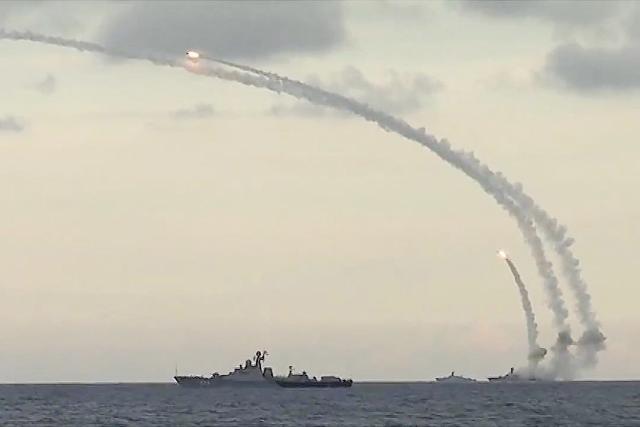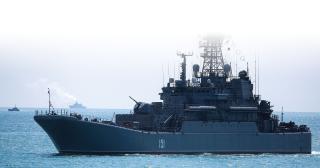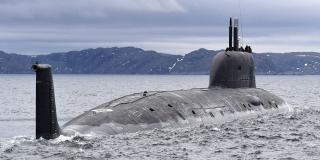Commander Joshua Menks, U.S. Navy, and Michael B. Petersen
Russia’s war in Ukraine has once again piqued interest in Moscow’s military, including its navy. While there has been no significant naval combat, and the Russian Federation Navy (RFN) has not played a central role outside of a handful of actions, the RFN has played a crucial strategic deterrence role against NATO during the current conflict. At the center of this strategic deterrence mission is a military philosophy that emphasizes long-range precision strikes against critical targets on land. This is a role the RFN has long prepared for, but it has received only limited attention.
Russia military watchers have written extensively about antiaccess/area-denial (A2/AD) and bastion defense.1 While this work has been welcome and undergone a positive evolution over time, as Western understanding of Russian thinking on these concepts has improved, it also tends to prejudice the defensive aspects of Russian warfighting.2 Only recently have Western observers begun exploring the more offensive (or “active defensive”) aspects of 21st-century Russian warfighting at the tactical, operational, and strategic levels of war.3 Russian writers have long believed in the importance of conventional precision-guided munitions in offensive operations, but deployment of these weapons over the past ten years has sharpened and increased the role of naval forces in the Russian strategic construct. This offensive role for naval forces remains underexamined by Western observers and is especially important considering Russia’s invasion of Ukraine.
The Rise of Precision Strike in the RFN
In the decade immediately after the fall of the Soviet Union, as Russia’s conventional capabilities withered and its navy rusted away, Russian military strategists were mostly forced to rely on strategic and nonstrategic nuclear forces for deterrence. But they recognized that relying on nuclear force, in many cases, especially in local and regional conflicts, lacked credibility. By the early 2000s, strategists began to explore adding conventional precision-strike weapons to the strategic deterrence mission, a concept first floated then discarded in the late Soviet period.4
On which service or services does this burden fall? Russia’s General Staff envisions joint and whole-of-government operations to maximize the effectiveness of its various flavors of strategic operations. But the all-important nonnuclear kinetic strikes mostly fall on Russia’s long-range aviation (LRA) and its navy. Kinetic strikes by strategic bombers using long-range precision-guided munitions (PGMs) are a capability Russia’s LRA has practiced for decades. But while the capability is obvious, the capacity is not. According to Jane’s Intelligence database, Russia has only 16 Tu-160 Blackjack strategic bombers available for service and 68 old Tu-95MS Bear propeller-driven strategic bombers. While this is larger than any other nation’s strategic bomber force except the United States, it is hardly a force that can mount a sustained, long-endurance, survivable threat to critical infrastructure, particularly against the continental United States.
The only other force capable of nonnuclear kinetic strikes is the RFN. Like virtually every other navy on the globe, the RFN is not immune to serious problems. But since the 1990s, it has been making successful strides toward constructing a force equipped with a modern, long-range precision-strike capability. This “Kalibrization” of the fleet has been well-documented.5 Less well-known is the substantial body of naval strategic and operational thought that has been developed over the past two decades that describe how this Kalibrized force may be employed in an offensive capacity.
Russian Conflict Periodization and the Need for Sustained Deployment

In November 2015, ships of Russia’s Caspian Flotilla fired Kalibr missiles at ISIS targets in Syria. The Russian Federation Navy has long been focusing on such precision strikes, and it is time NATO pay attention. Credit: Alamy
Crucial to understanding the importance ascribed to the RFN in future conflicts are the concepts of Russian strategic deterrence and conflict periodization. Russian strategic deterrence combines elements of both compellence and deterrence.6 It involves whole-of-government efforts to dissuade potential adversaries from conducting unwanted operations or starting a conflict, as well as careful escalation-management functions designed to end a conflict on terms favorable to Moscow. These functions may include carefully dosed conventional and nonstrategic nuclear weapon strikes designed to maintain escalation advantage.7
Russian periodization of conflict is the other key to understanding why the RFN has an increasingly important role in strategic thinking. The two key periods of conflict, according to Russian thinkers, are the “threatening period” and the “initial period of war.”8 The threatening period occurs when relations between states deteriorate, potentially leading to war. Russia’s military doctrine notes that one of the characteristics of modern conflict is the “reduction of the time periods required for preparing to conduct military operations.”9 Because this period has become so compressed, Russian thinkers largely believe the only opportunity to deploy military forces is prior to and during the threatening period for strategic deterrence operations.10
Following the threatening period, the initial period of war is, according to Russia’s Defense Ministry, the period “during which belligerent states conduct military operations engaging groups of armed forces deployed before the outbreak of the war to achieve immediate strategic objectives or to establish favorable conditions for the main forces’ entry into the war.”11 It is driven by the need to both achieve and defend against strategic surprise.12
Thus, strategic deterrence requires maintaining standing combat forces at high readiness to short-circuit a surprise attack or dissuade conflict in the first place. In both cases, Russia observers expect the RFN to play a critical role in global strategic deterrence to limit Western “adventures.”13 Because war is expected to start with little or no warning, they see naval forces that “can speedily achieve operational deployment into the area of conflict situations and stand by on high alert” as highly suited to deterrence operations.14 The Fundamentals of Russia’s State Naval Policy points out that “The Navy is one of the most effective instruments of strategic (nuclear and nonnuclear) deterrence,” in part because of its ability to “deploy naval expeditionary groups in a short period of time into the areas of conflict and remain in these areas for an extended period of time.”15 Rapid, survivable, and sustained forward presence is viewed as essential to achieving Russia’s strategic deterrence objectives. These ideas underpin much of the motivation behind Russia’s naval modernization, which in turn features the development of long-range strike on critical targets.16
Naval Operations Against Critical Infrastructure
Autumn 2015 proved to be a watershed moment in the RFN’s recent history. In October, four surface ships in the Caspian Flotilla fired 26 cruise missiles from the Caspian Sea, striking ISIS targets in Syria.17 The same ships struck again that November, while Kilo-class diesel-electric submarines in the Mediterranean launched ten more cruise missiles into Syria.18 Finally, on 7 December, another Kilo-class submarine fired yet more cruise missiles into Syria from the eastern Mediterranean.19 These attacks—which targeted weapon depots, oil facilities, military production factories, and command centers—were the first combat use of the land-attack variant of the RFN’s new long-range, high-precision Kalibr cruise missile, known by Russia as the 3M-14 and by NATO as the SS-N-30A. These strikes also provided a glimpse into an emerging RFN strategic philosophy.
Aside from the well-known missions of layered bastion defense and strategic nuclear deterrence, Russia’s General Staff has assigned the RFN an offensive counter–critical-infrastructure mission.20 It notes that among many tasks, the Navy will “destroy enemy land-based facilities at long distances.” It will also attack “coastal facilities” supporting naval warfare and be called on to conduct fires ashore in support of troops in contact. Instances of each have taken place in Ukraine.21 The type of strikes, whether conventional, nonstrategic nuclear weapons, or strategic nuclear weapons, largely depends on the level of conflict (local, regional, large-scale, or global nuclear), and the assigned level of intended damage.

The Black Sea Fleet, according to its former commander, is capable of long-range precision strikes on land-based infrastructure that could cripple Russia’s foes. Credit: Alamy
Russia’s official naval doctrine puts a finer point on it. It states that one of the navy’s roles is to “attack the critically important ground-based facilities of the adversary, without violating, until a certain moment, its national sovereignty.” It further notes that “with the development of high-precision weapons, the Navy faces a qualitatively new objective: destruction of the enemy’s military and economic potential by striking its vital facilities from the sea.”22 The Kalibrization of the RFN has made this mission possible.
These missions against “critically important” facilities fall under the umbrella term known in English as “strategic operations to destroy critically important targets,” or SODCIT. According to Russian analysts, the RFN has a critical SODCIT role, using carefully dosed attacks with conventional precision-strike weapons against targets in ways that will yield specific effects. At the tactical, operational, and strategic levels of war, these targets can vary but can include “critically important ground-based facilities of the adversary and marine carriers that are the global strike assets before these can move to the line of weapon employment, and also the marine components of the U.S. national AMD [missile defense] system in the shortest possible time.” They also can include key command-and-control nodes as well as economic, industrial, and even political targets.23
A close reading of Russian thinking in this regard may help reevaluate theories of open-ocean sea-lines-of-communication warfare. The notion that the RFN will hunt for transatlantic convoys has had remarkable staying power, despite efforts to debunk it.24 While one can never fully ignore this risk, discussion in Russian strategic literature favors attacks on landward logistics hubs such as sea points of debarkation. The idea of fires from the sea to the shore is commonplace, and broadly accepted in Russia, as are its implications that “submarines can now not chase the seas and oceans for ships carrying strategic cargo, but strike them right in ports, striking them from pistol- and long-distance.”25 Such a strategy is an elegant solution to what otherwise would require an information-gathering and numbers-intensive campaign, both of which are limitations of Moscow’s blue-water navy.
Europe at Risk
Given Russian naval force structure and capability, Europe currently is at greater risk than the continental United States of being targeted with these strikes.26 Most of Russia’s new Kalibrized naval platforms are smaller, with limited endurance and fewer vertical launch tubes to accommodate land-attack cruise missiles. As such, they are, with the possible exception of the Admiral Gorshkov-class frigates, poorly suited to extended blue-water operations. However, the extended range of the Kalibr land-attack variant makes it possible to strike targets across most of Europe from sanctuary. For example, former Black Sea Fleet commander Admiral Alexander Vitko has pointed out:

Russia’s nuclear-powered, Kalibr-equipped Yasen-class submarines are capable of mounting a periodic threat to the U.S. mainland, and this threat will grow as more of these submarines enter the fleet. Credit: Alamy
In the Southwest, only the Black Sea Fleet has such [Kalibr] weapons . . . and is capable of dealing missile strikes, using high-precision weapons, against critically important infrastructure assets belonging to the potential adversary at up to 1700 km. . . . This permits us to strike targets directly from the Black Sea waters, where Russian warships are reliably covered not only by coastal long-range missile systems, but also by tactical aviation.27
In Ukraine in March 2022, a Black Sea Fleet ship off Sevastopol put words into action, launching eight SS-N-30As and supposedly destroying a weapons depot in northwestern Ukraine.28 Aside from this, there has been little verifiable evidence of other Kalibr strikes during the war. However, there are reportedly five Kalibr-capable vessels operating among the 15 RFN warships in the Mediterranean, as of late March.29 This is an indication that Moscow is instead using its navy for a strategic deterrence mission against NATO, including the threat of land attack, while it fights its war against Ukraine.
Currently, RFN critical infrastructure missions against the continental United States are possible, but much more difficult, given the limited number of long-endurance, stealthy, survivable Kalibr-capable platforms. This mission probably falls to two platforms—the Northern Fleet’s famous Yasen-class nuclear-powered submarine Severodvinsk and the modernized Yasen-M Kazan. The RFN accepted a second Yasen-M, the Novosibirsk, at the end of December 2021, but it does not appear she has yet deployed.30 As such, the RFN is only able to mount a periodic conventional threat to the U.S. homeland. This will likely change as more Kalibr-capable nuclear-powered submarines enter the fleet over the next decade.
Implications
The Atlantic is no longer a moat protecting North America from Russian conventional weapons. If the United States is to properly address challenges presented by the Russian Federation Navy, it must first understand them. Russian long-range precision fires from sea to land are here to stay. They are a vital part of that country’s 21st-century warfighting strategy. The RFN will continue to expand and deepen these capabilities because they are the centerpiece of Russia’s strategic deterrence efforts.
As Russia expands and deepens its capability, the United States and NATO must be wary of operations that depend on large concentrations of force at fixed infrastructure sites and must pursue strategies aimed at minimizing damage to fixed infrastructure. Distributed infrastructure and logistics, as well as targeted investment in air defense capabilities, will help mitigate risk. Decentralized command and control, improved counter intelligence, surveillance, and reconnaissance, as well urgent efforts to track and, if necessary, destroy Russian Kalibr-capable platforms will only increase in importance.
No comments:
Post a Comment